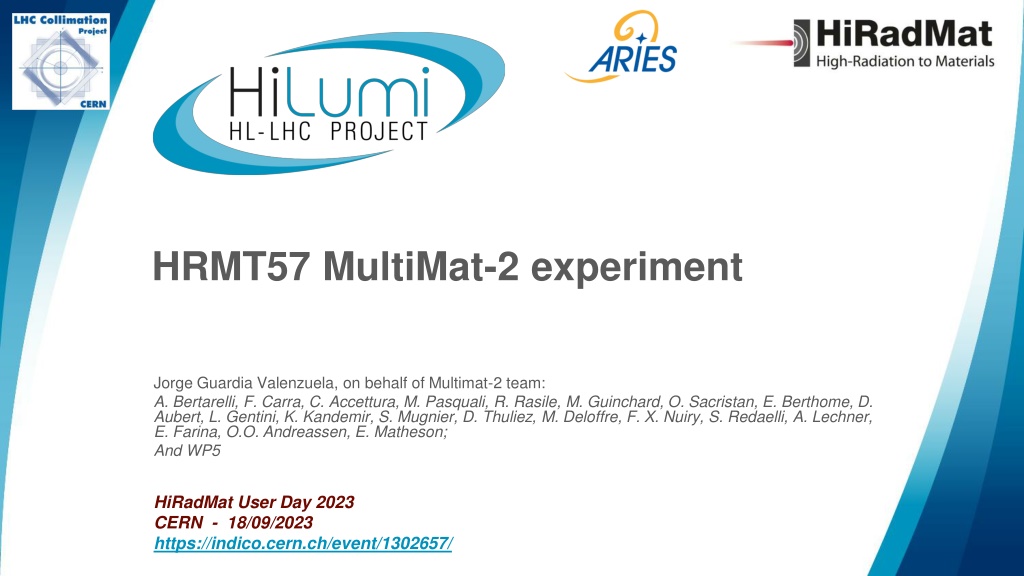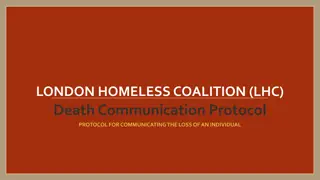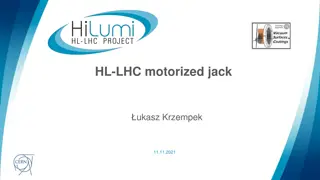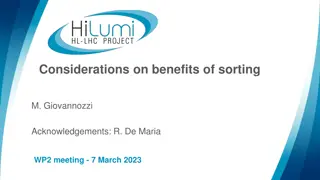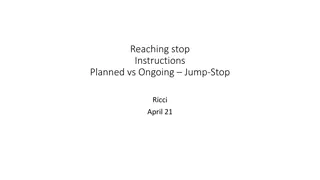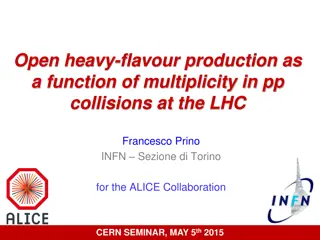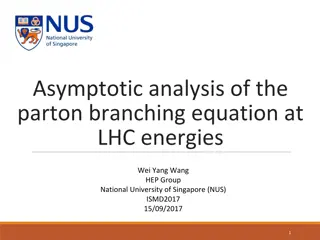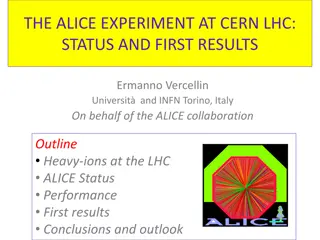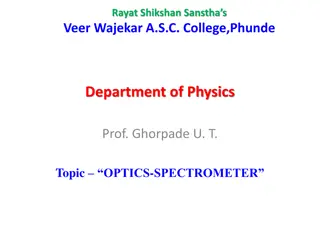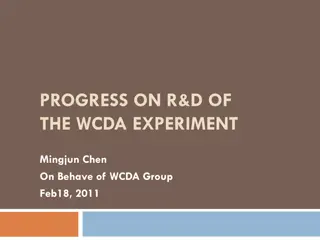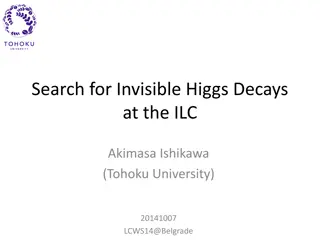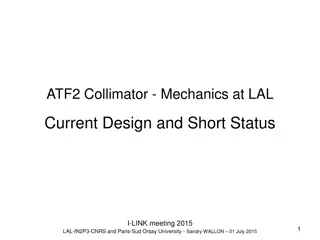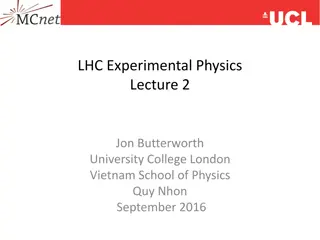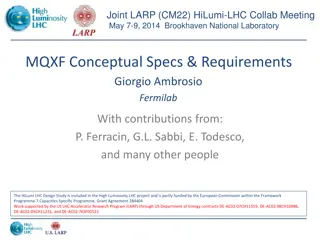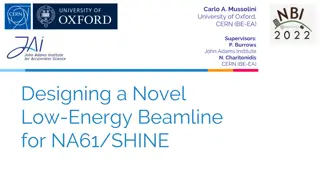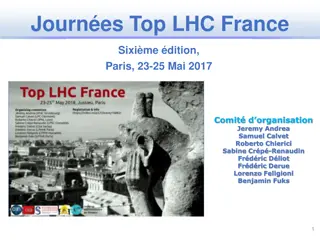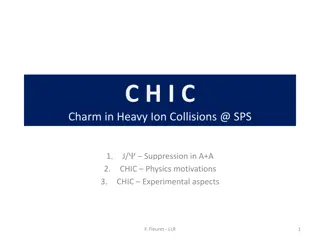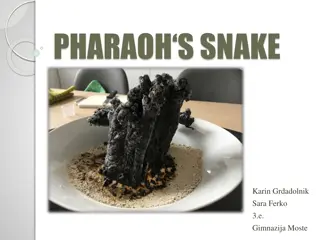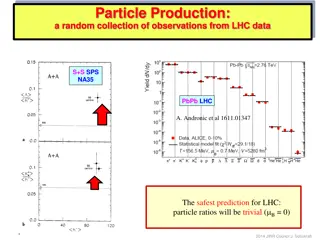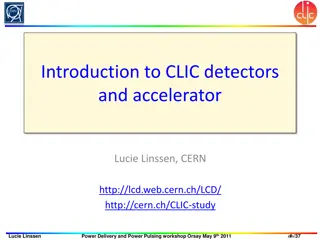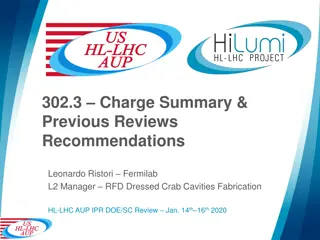Multimat-2 Experiment: Advancements in HL-LHC Collimator Technologies
The Multimat-2 experiment conducted by Jorge Guardia Valenzuela and the team at CERN focused on testing prototypes of HL-LHC collimators, including materials and coatings, to improve the robustness and performance under extreme conditions. The goals included deriving strength models, exploring failure modes of materials, and pushing energy thresholds to observe damage thresholds. By exceeding previous limits and refining models, the experiment aimed to validate industrial grades for collimator production and enhance understanding of material behaviors. Extensive instrumentation and testing platforms were utilized to achieve these objectives.
Download Presentation

Please find below an Image/Link to download the presentation.
The content on the website is provided AS IS for your information and personal use only. It may not be sold, licensed, or shared on other websites without obtaining consent from the author. Download presentation by click this link. If you encounter any issues during the download, it is possible that the publisher has removed the file from their server.
E N D
Presentation Transcript
HRMT57 MultiMat-2 experiment Jorge Guardia Valenzuela, on behalf of Multimat-2 team: A. Bertarelli, F. Carra, C. Accettura, M. Pasquali, R. Rasile, M. Guinchard, O. Sacristan, E. Berthome, D. Aubert, L. Gentini, K. Kandemir, S. Mugnier, D. Thuliez, M. Deloffre, F. X. Nuiry, S. Redaelli, A. Lechner, E. Farina, O.O. Andreassen, E. Matheson; And WP5 HiRadMat User Day 2023 CERN - 18/09/2023 https://indico.cern.ch/event/1302657/
Outline Experiment overview Goals Materials Preparation, beam time and disassembly Pulse list Summary of tests Conclusions 2 J.Guardia - 18/09/2023
Multimat test bench for HiRadMat studies Multimat-1 experiment (HRMT36) performed in October 2017 Multimat-2 experiment (HRMT57) performed in September 2021 (20-24th) Al vessel hosting under inert gas a rotatable barrel equipped with 16 target stations, each one embarking up to 8 slender specimens, with rectangular cross-section Extensive instrumentation: strain gauges, temperature sensors, LDV, rad-hard camera Low-cost testing platform, reused from past HiRadMat tests HRMT57 The longitudinal total strains occurring on the outer surface of the most loaded R4550 sample impacted by 288 bunches of intensity 1.25 1011 p/b and = 0.5 mm. The effects of grazing pulses on Cu and Mo coatings, together with the implemented beam parameters 3 J.Guardia - 18/09/2023
Multimat-2 goals vs. Multimat-1 Multimat-1: successful from several points of view! Demonstration of prototypes of HL-LHC collimators technological solutions (materials and coatings) CuCD tested under LHC accidental scenario (24 bunches) Derivation, for the first time, of a robust strength model with damping for the graphitic materials, and refinement of the constitutive model of metals and CuCD Individuation of failure mode for anisotropic graphitic materials, strongly dependent on longitudinal/transversal stress coupling For the first time we exceeded the maximum HL- LHC energy per section, observing the damage Threshold 1 both for ??and ?? What is still missing? Validation of material specific industrial grades and coatings used in HL-LHC collimators series production Test CuCD under HL-LHC accidental scenario (48b) Derivation of the strength model for the industrial grade MoGr, and benchmarking of the models for the other materials Define a failure model for the anisotropic graphitic materials, better characterizing the transversal stress domain, by increasing the dedicated instrumentation Explore higher thresholds of damage for the graphitic materials, via dedicated target stations 4 J.Guardia - 18/09/2023
Multimat-2 List of materials tested NB-8304Ng (MoGr grade used for LS2 production), uncoated and coated with Mo by HIPIMS NB-8404Ng (MoGr grade used for LS2 production, finer powders), uncoated and coated with Mo by HIPIMS Isotropic graphite uncoated and coated with Mo by HIPIMS Isotropic graphite uncoated and coated with Cu by HIPIMS 1. 2. 3. 4. HL-LHC collimator baseline and alternatives CuCD from Nanoker used for IR collimator prototype (TCTPXH) 5. Additional novel/known materials/equipment for BID and/or societal applications CFC FS140K for better deriving failure model by monitoring transverse waves 6. MoGr#3 denser MoGr for industrial application CrGr#1 metal carbide graphite composite Instrumentation (test the effect of the beam on strain measurements) 7. 8. 9. 10. Parking station 5 J.Guardia - 18/09/2023
Motivations and Objectives for HiRadMat Impact Tests Explore and determine consequences of Failure Scenarios affecting machine performance for LHC Run 2, Run 3 and HL-LHC: Reference failure scenario in secondary collimators (MoGr): Failure Scenario Beam Type Beam Energy [TeV] Intensity Deposit. [p+] Beam Emittance [ m] RMS beam size [mm] 288b@1.2E11p/b@0.44 TeV, =0.25 mm in HRMT specimens (reduced cross-section): Equivalent average energy ( max) in the most loaded cross-section and peak energy density (Umax) Injection Error LHC Ultimate 0.45 4.9e13 3.5 1 Injection Error Run 2 BCMS 0.45 3.7e13 1.3 0.61 Injection Error HL-LHC 0.45 6.6e13 2.1 0.77 Injection Error LIU BCMS 0.45 5.8e13 1.3 0.61 Reference failure scenarios in tertiary collimators (CuCD): Asynchronous Beam Dump BCMS Run 2 7 1.3e11 1.3 ~0.5 Asynchronous Beam Dump 24b@1.2E11p/b@0.44 TeV 48b@1.2E11p/b@0.44 TeV =0.5 mm in HRMT specimens: Equivalent damage HL-LHC 7 2.3e11 2.1 ~0.6 Requirements for the Collimation System to be addressed (from Run1 to HL-LHC): Demonstrate the viability of a low-impedance collimator solution (long-standing limitation on intensity reach, amplified by HL-LHC settings) Mitigate/remove TCT robustness limit that affected operational choices of beta* and optics of present machine Re-assess robustness of present carbon-based design (TCS and TCP) against injection failures with smaller emittances 6 J.Guardia - 18/09/2023
Preparation & beam-time 598 signal cables Arrival to B.112 05/May/2021 Instrumentation &cabling completed 03/Sep/2021 Last tests on BA7 14/Sep/2021 Transport to HRMT tunnel 16/Sep/2021 (Beam time: 20-24/Sep/2021) 7 J.Guardia - 18/09/2023
Multimat-2 Pulse list Delivered pulses (excl. align. / max. intensity) Material (coating) Bunches per pulse Average intensity I [p/b] Beam size (mm) NB-8304Ng (Mo) NB-8404Ng (Mo) R4550 (Mo) R4550 (Cu) CuCD 25 (5 / 1@288b) 1-288 1.06E+11 0.25, 0.5 46 (8 / 2@288b) 1-288 1.09E+11 0.25, 0.5 28 (6 / 3@288b) 39 (7 / 3@288b) 58 (4 / 1@48b) 1-288 1-288 1-48 1.07E+11 1.07E+11 1.07E+11 0.25, 0.5 0.25, 0.5 0.5 TT66 Be window broke just before the experiment end (next slide) CFC FS140K 42 (7 / 1@288b) 1-288 1.08E+11 0.25, 0.5 NB-2507Ng 14 (4 / 1@288b) 1-288 1.07E+11 0.25, 0.5 CrGr 18 (7 / 1@288b) 1-288 1.08E+11 0.25, 0.5 Instrumentation 5 (5 / 1@288b) 36-288 1.11E+11 0.25 Multimat-2 requested beam parameters Experiment run Intensity/bunch Up to 1.2E11 p (higher intensity, if available, would be very welcome) Average 1.075E11 p/bunch Spot size Down to 0.25 mm 0.28x0.22 mm * more alignment pulses than planned, and ~10 less high-intensity pulses than expected due to rupture of SPS extraction line beryllium window N. pulses ~250 including pilot bunches 276* Integral intensity ~2E15 p 58x 288b pulses 7.2E14 p 23x 288b pulses 8 J.Guardia - 18/09/2023
TT66 Be window rupture SPS HRMT extraction line vacuum level >1E-4 mbar 4:46AM 24/09/2021 5:21AM <1E-7 mbar 8x 288b extractions Multimat-2 tank upstream beryllium window no damage Vacuum side SEM observations Impacts not executed: Grazing on Mo-coated NB-8304Ng (HL-LHC material) Grazing on CFC (HL-LHC material) Grazing on CrGr (R&D material) Grazing on NB-2507Ng (R&D material) Offset shot on CFC/graphite (Test material limits) Material equivalent to NB-8404Ng, which was correctly tested Lower priority tests Image (06/10/2021) showing marks from some of the high-intensity shots. (vacuum leak-tight tested on 13/10/2021 OK!) Photo from P.Simon s presentation at 132nd EATM https://indico.cern.ch/event/1074326/contributions/451 7861/attachments/2308917/3928651/HRMT_beW.pdf 9 J.Guardia - 18/09/2023
Post-irradiation examination: tank opening (B.109) 12/04/2022 - 13/04/2022 10 WP5.2 Technical meeting, CERN 16-05-2022, https://indico.cern.ch/event/1076799/ J.Guardia - 18/09/2023
Multimat-2: Summary of tests done Grazing impacts on coatings: FLUKA energy deposition calculations Visual inspection Surface optical topography Optical microscopy + SEM Coating adhesion tests MoGr line centred impact Centred impacts: FLUKA energy deposition calculations Visual inspection Micro-computed tomography (before + after irradiation) Strain & temperature data acquisition, benchmarking Gr+Cu (grazing impact) 11 J.Guardia - 18/09/2023
Conclusions and next steps Successful experiment: providing the needed scientific results for the HL-LHC collimation project. Main issues: Rupture of the TT66 Be window dedicated post-mortem working group Slight limitation in beam intensity Kicker magnets heating-up HL-LHC bulk collimator materials validated (no relevant damage): MoGr (both NB-8304Ng and NB-8404Ng) and CuCD Isotropic graphite Coatings: All coatings are damaged by grazing impacts. Coatings on graphite are less damaged than on MoGr: less energy deposition and higher substrate strength. More technical details given at the ColUSM #153 02/09/2022 https://indico.cern.ch/event/1189092/ Beam-Impact Validation of HL-LHC Collimator Materials: the MultiMat-2 Experiment F. Carra; C. Accettura; A. Bertarelli; E. Berthome; R. Bruce; N. Charitonidis; M. Dalemir; E. Farina; J. Guardia-Valenzuela; M. Guinchard et al. 14th International Particle Accelerator Conference 2023-06-08 | Conference paper DOI: 10.18429/JACoW-IPAC-23-WEPM109 Publication (HL-LHC collimator materials) Other HRMT-57 results to be published in an extensive summary report. 12 J.Guardia - 18/09/2023
Acknowledgements: HiRadMat (BE/EA), RP (HSE/RP), Control Room (BE/OP & SPS coordination), Transports (EN/HE), Survey (BE/GM), Controls (BE/CEM), Beam instrumentation (SY/BI), Collimation & FLUKA team (SY/STI), Collimation project & impedance (BE/ABP), Metrology & Metallurgy Laboratories (EN/MME) Special thanks to: N. Conan, F. Philippon, A. Ebn Rahmoun, P. Simon, N. Charitonidis, O.O. Andreassen, E. Matheson, B. Bulat, D. Pugnat, S. Burger, and SPS operators - technical coordinators! 13 J.Guardia - 18/09/2023
